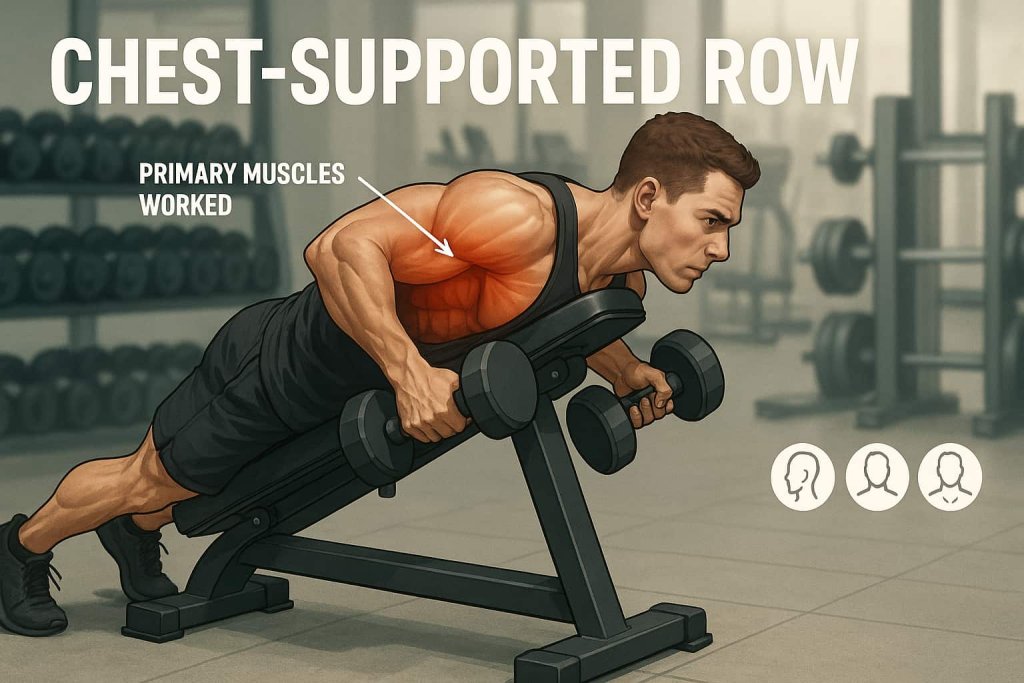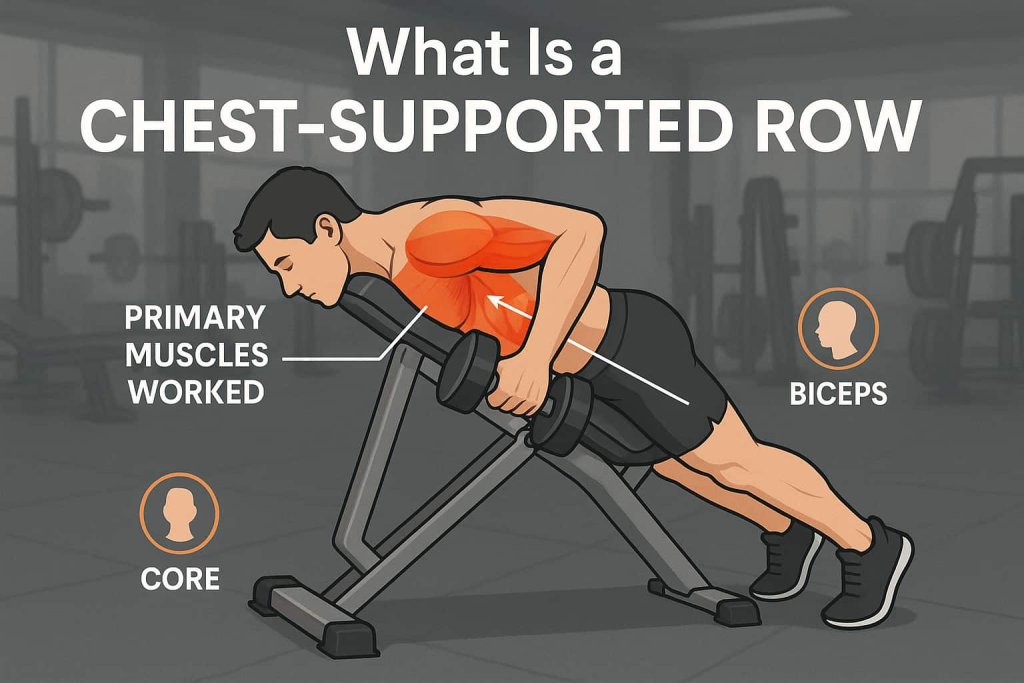The chest-supported row is one of the best exercises for building a stronger, safer back. Unlike traditional bent-over rows, this movement keeps your torso supported, which removes lower-back strain and lets you focus purely on muscle activation.

Understanding proper form is crucial because it ensures maximum engagement of the lats, rhomboids, and traps while minimizing injury risk. Whether you’re a beginner learning back training or an advanced lifter looking to push hypertrophy, the chest-supported row is a staple exercise worth mastering.
This guide covers form, benefits, variations, mistakes to avoid, and programming so you can confidently include chest-supported rows in your routine.
What Is a Chest-Supported Row?
A chest-supported row is a back-strengthening exercise performed face-down on an incline bench, usually set at a 30°–45° angle. You row dumbbells, a barbell, or a machine handle toward your torso while keeping your chest braced against the bench.

- Primary Muscles Worked: Lats, rhomboids, trapezius, rear deltoids
- Secondary Muscles: Biceps, forearms, core stabilizers
- Equipment Used: Incline bench, dumbbells, barbell, or chest-supported row machine
👉 Unlike bent-over rows, this variation removes lower-back strain by keeping the torso supported, making it ideal for beginners, lifters with back issues, or athletes needing safer progression.
How to Do the Chest-Supported Row (Step-by-Step)
- Set the Bench
Adjust an incline bench to 30°–45°. - Position Yourself
Lie face-down with your chest against the pad. Keep feet planted and abs engaged. - Grip the Weights
Hold dumbbells or a barbell with either neutral (palms facing), overhand, or underhand grip. - Initiate the Row
- Start with arms fully extended.
- Retract your shoulder blades first.
- Pull elbows back toward your rib cage.
- Squeeze and Control
Pause briefly at the top, squeezing your back muscles. Slowly lower the weights to the starting position. - Breathing
Exhale on the pull, inhale on the way down.
✅ Trainer Tip: Keep your chest glued to the bench—don’t arch up or swing for momentum.
Common Mistakes to Avoid
- Lifting Too Heavy → sacrifices form and increases injury risk.
- Bouncing Off the Bench → removes muscle tension.
- Neglecting Scapular Retraction → turns the row into an arm exercise instead of a back builder.
- Neck Hyperextension → keep your head neutral, not craned up.
Benefits of Chest-Supported Rows

1. Protects the Lower Back
Because your torso rests on a bench, there’s no spinal compression from holding a hinge position. This makes it safer for those with back issues.
2. Isolates the Upper Back
You can focus on squeezing your shoulder blades without worrying about balance or momentum. This leads to stronger mind–muscle connection.
3. Builds Better Posture
Stronger rhomboids and traps pull your shoulders back, counteracting the effects of sitting and slouching.
4. Boosts Strength in Other Lifts
A strong, stable upper back improves squats, deadlifts, and bench press lockout power.
5. Beginner- & Injury-Friendly
With a fixed setup and guided path, chest-supported rows allow safer progression and consistent overload.
Variations of Chest-Supported Rows
Here’s a breakdown of the most powerful variations you can include in your training:
1. Dumbbell Chest-Supported Row
- Why it works: Dumbbells give you independent loading on each arm, which improves balance and ensures both sides of your back work equally. They also allow for neutral, overhand, or underhand grips, giving flexibility in muscle targeting.
- Muscles worked: Lats (width), rhomboids (scapular retraction), traps, rear delts, and biceps.
- Benefits:
- Greater range of motion than barbells or machines.
- Excellent for hypertrophy and joint health.
- Trainer Tip: Pause at the top of the movement for 1–2 seconds to reinforce scapular retraction and increase time under tension.
2. Barbell Chest-Supported Row
- Why it works: With a barbell, you can load more weight, making this variation ideal for building brute pulling strength and mid-back thickness.
- Muscles worked: Mid traps, rhomboids, and erector spinae stabilizers.
- Benefits:
- Best variation for progressive overload.
- Perfect for strength athletes like powerlifters.
- Trainer Tip: Keep elbows tucked at ~45° to protect the shoulders and emphasize lats. Avoid jerking the bar off the floor.
3. Single-Arm Chest-Supported Row
- Why it works: By rowing with one arm at a time, you build unilateral strength and reduce muscular imbalances. It also engages obliques and deep core muscles to resist rotation.
- Muscles worked: Lats, rhomboids, traps, rear delts, obliques (anti-rotation).
- Benefits:
- Identifies and fixes weak-side lag.
- Improves mind-muscle connection with the lats.
- Trainer Tip: Place the non-working hand lightly on the bench for balance—don’t twist your torso to “cheat” the rep.
4. Chest-Supported T-Bar Row
- Why it works: This bodybuilding favorite allows you to move heavy loads with a neutral grip, reducing strain on wrists and elbows while maximizing back thickness.
- Muscles worked: Rhomboids, traps, lats, and posterior delts.
- Benefits:
- Mid-back emphasis for that dense, 3D look.
- Works well with drop sets and pyramid loading schemes.
- Trainer Tip: Control the eccentric—don’t slam the plates down at the bottom.
5. Cable Chest-Supported Row
- Why it works: Cables offer constant tension throughout the movement, something free weights can’t provide. This makes them joint-friendly and excellent for hypertrophy.
- Muscles worked: Lats, traps, rhomboids, biceps.
- Benefits:
- Great for high-rep, pump-style training.
- Smooth resistance curve protects elbows and shoulders.
- Trainer Tip: Experiment with different attachments (V-bar, rope, wide grip) to emphasize different back regions.
Programming & Rep Ranges
- Hypertrophy (muscle growth) → 8–12 reps, 3–4 sets
- Strength → 5–8 reps, 3–5 sets with heavier load
- Endurance/Rehab → 12–20 reps, lighter weights
Include chest-supported rows in upper-body days, pull days, or accessory lifts after compounds like deadlifts.
Who Should Add Chest-Supported Rows?
- Beginners → Safe way to learn rows.
- Bodybuilders → Adds back thickness.
- Powerlifters → Supports deadlift and bench.
- Rehab Clients → Low spinal stress option.
- Athletes → Improves posture and pulling power.
Best Alternatives to Chest-Supported Rows
Not every gym has incline benches, seal-row setups, or chest-supported machines. The good news: you can still hit your back hard with these proven alternatives.
1. Bent-Over Barbell Row
- Why it works: The gold standard of back training, bent-over rows build overall size, strength, and spinal stability.
- Muscles worked: Lats, rhomboids, traps, spinal erectors, and forearms.
- Benefits:
- Unmatched for mass and pulling power.
- Mimics athletic movements like wrestling, grappling, and rugby scrums.
- Common Mistake: Rounding the lower back. Always hinge at the hips and keep the bar close to your shins.
2. Single-Arm Dumbbell Row
- Why it works: A staple for unilateral strength, posture correction, and lat hypertrophy. It’s accessible and doesn’t require much equipment.
- Muscles worked: Lats, traps, obliques (stability), and forearms.
- Benefits:
- Strengthens postural alignment by balancing left-right weakness.
- Can be loaded heavy without risking spinal strain.
- Trainer Tip: Think about driving the elbow back toward your hip, not shrugging the shoulder upward.
3. Seated Cable Row
- Why it works: Keeps the lower back upright and supported, making it beginner-friendly. The adjustable handles allow multiple grip angles.
- Muscles worked: Rhomboids, lats, traps, biceps.
- Benefits:
- Easy on the lower back.
- Great for high-volume hypertrophy training.
- Trainer Tip: Don’t lean back excessively—keep tension on the back, not the hips.
4. T-Bar Row (Free-Standing)
- Why it works: Similar to bent-over rows but allows greater loading and tighter grip angles, making it excellent for thickness.
- Muscles worked: Mid-back (rhomboids, traps), lats, spinal erectors.
- Benefits:
- Heavy loading potential.
- Versatile grip options (neutral, wide, close).
- Trainer Tip: Brace your core hard—free-standing T-bar rows tax the lower back more than chest-supported versions.
5. Inverted Row (Bodyweight)
- Why it works: Uses bodyweight to develop scapular control, grip endurance, and pulling strength. Scales easily by adjusting foot position.
- Muscles worked: Lats, traps, rhomboids, core, biceps.
- Benefits:
- Great for beginners, rehab, or warm-ups.
- Builds core stability alongside pulling strength.
- Trainer Tip: Elevate feet on a bench to increase difficulty; bend knees to regress.
6. Seal Row
- Why it works: Performed lying face-down on a high flat bench, seal rows remove all momentum and spinal loading, making them one of the strictest horizontal pulls.
- Muscles worked: Lats, rhomboids, mid traps.
- Benefits:
- Strict form = maximum back isolation.
- Safer for lifters with back issues.
- Trainer Tip: Keep weights moderate—this exercise is about control, not brute force.
Chest-Supported Row vs. Bent-Over Row
| Feature | Chest-Supported Row | Bent-Over Row |
|---|---|---|
| Back Safety | ✅ Lower-back supported | ❌ High spinal load |
| Muscle Isolation | ✅ High | ❌ Lower |
| Weight Capacity | ✅ Heavy & safe | ✅ Heavy, but risky |
| Technique Strictness | ✅ Strict | ❌ Easy to cheat |
| Best For | Beginners, rehab, hypertrophy | Advanced lifters, overall strength |
FAQs About Chest-Supported Rows
1. Are chest-supported rows better than bent-over rows?
Yes, for isolating the back safely. Bent-over rows train more stabilizers, but chest-supported rows protect the spine.
2. What bench angle is best?
Between 30°–45°—steeper targets traps/rear delts, shallower emphasizes lats.
3. Can beginners do chest-supported rows?
Absolutely—machines or dumbbells are beginner-friendly.
4. How heavy should I go?
Use a weight that lets you maintain full chest contact and controlled reps (8–12 rep range works best for growth).
5. Do they build lats or traps more?
Grip angle matters: neutral/underhand hits lats, overhand favors traps and rhomboids.
6. Should I pause at the top?
Yes—holding the squeeze for 1–2 seconds increases muscle activation.
7. Can I replace pull-ups with chest-supported rows?
Not directly—pull-ups train vertical pulling, while chest-supported rows are horizontal pulling. Use both for balance.
Conclusion
The chest-supported row is a must-have back exercise if you want strength, size, and safety. By keeping your torso supported, you remove lower-back stress and unlock greater focus on the lats, traps, and rhomboids.
👉 Add chest-supported rows into your pull day or back workout, vary grips, and progress weight smartly for long-term results.
Ready to strengthen your back safely? Try chest-supported rows next workout and feel the difference.
